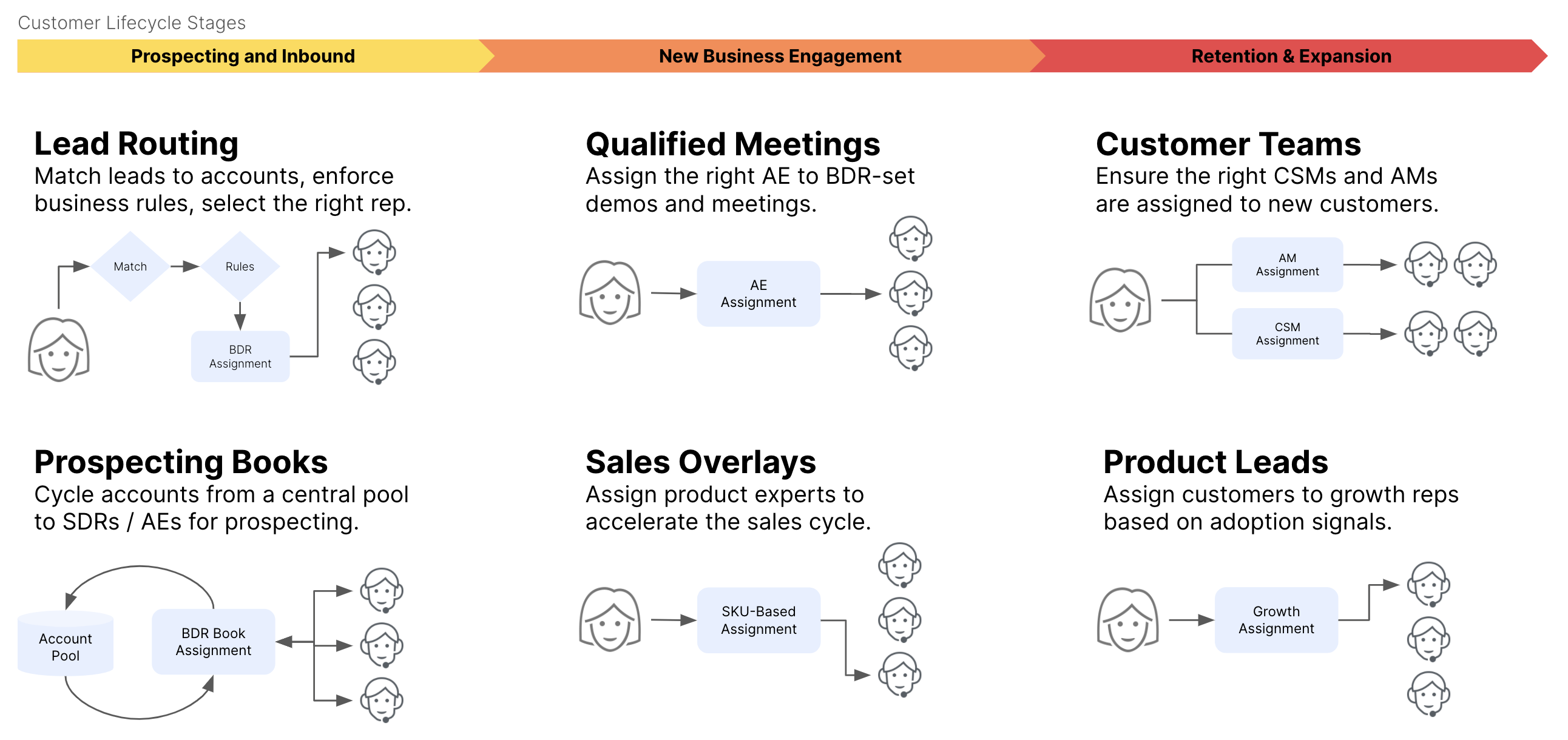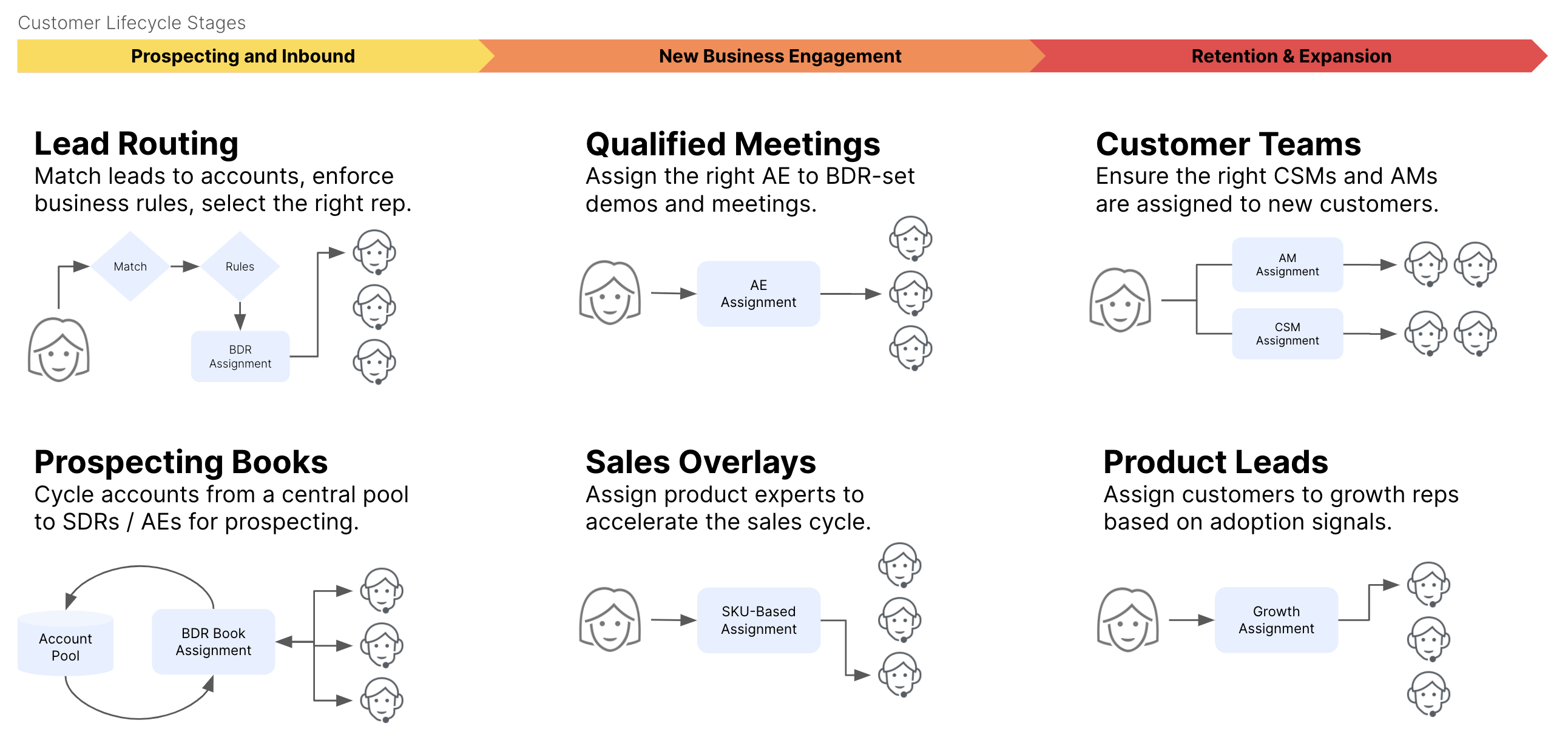I wrote my first post for Gradient Works about managing sales rep assignment throughout the customer lifecycle. Not only is assignment one of the most important concepts in high-velocity revenue organizations, but that post also gave me an excuse to introduce what we've come to call the Assignment Mullet: "automation in the front, spreadsheets in the back".
It's been about six months since that last post so it seems like a good time to make like an 80s cover band at their first post-pandemic gig and revisit the mullet. If you're wondering what I mean by "automation in the front, spreadsheets in the back", here's a quick primer.
In most organizations, the rep assignment process that gets all the automation love is at the beginning of the customer journey: inbound lead assignment. As you move to later stages in the customer journey, the processes tend to get more and more manual; hence the spreadsheets.
Our previous post included some high-level recommendations. In this post, we'll go a bit deeper and look at the type of assignments you'll encounter as you traverse the Assignment Mullet.

Inbound Leads
Welcome to the front of the mullet.
Sales organizations love inbound leads. Why wouldn't you? These folks have found you, they've pressed a button or downloaded a whitepaper, they want to know more right now. Of course, you want to oblige them by building a process to get that lead quickly assigned to a rep. We've all seen the studies that indicate that response time is incredibly important.
In addition to speed, there's an immediate data quality problem. Inbound leads are messy. Most of the time the information is provided by the user and requires that you subsequently do lead-to-account matching to make sure you get the lead to the right place.
Once you've done your matching, you still need to make sure that you're routing the lead to an appropriate rep based on your territories, market segments, rules of engagement, etc.
The high volumes (hopefully!), need for speed and complexity naturally lead us towards automation for the lead routing process. This is why the "automation in the front" part of the assignment mullet exists.
Prospecting Books
Most organizations don't run on inbounds alone; they usually have an outbound team of sales development reps (SDRs). Day in and day out these folks are responsible for doing cold outreach to prospects trying to set meetings. It's an incredibly hard job that involves a lot of rejection and a lot of repetition. The best organizations work hard to keep their SDRs "fed" with high-quality prospects so they stay focused on doing outreach, not hunting through Salesforce for someone to call.
Increasingly this takes the form of "cycling" accounts in and out of rep "books". Each rep will be responsible for a book of accounts at any given time. When an account in the book has either been worked to "completion" (received a full outbound sequence without a response) or says no, the account gets removed from the rep's name and placed in a pool of "resting" accounts. Then, a new account gets moved into the rep's name for outreach. While we've focused on the negative outcome, this replacement also applies to the positive outcome when an account is qualified and sent on to an account executive.
This centralized process is a great example of how your systems can keep your reps focused on The Good Place. Because of the continuous nature of this cycling process, it really needs to be automated. In sophisticated sales organizations, this may also be part of the front of the mullet.
Qualified Meetings
Congratulations! Your intrepid BDR team has qualified a prospect, either from an inbound or through outbound outreach. Now it's time to hand that prospect off to an account executive (AE). This is, of course, yet another assignment.
Some organizations adopt a "pod" model where BDRs and AEs work together in a small team. In this case, a BDR may always be handing off to the same AE which makes the assignment process pretty simple. The pod model is usually associated with a geographic territory model and suffers from many of the same resource allocation issues. However, it can be a good way to drive teamwork and camaraderie between BDRs and AEs.
Organizations that have moved beyond the geographic model, will often have a team of BDRs handing off to a team of AEs. While this is better than the pod model from a resource allocation standpoint, it makes assignment more complex - because at a minimum, it's necessary to use a round-robin system to allocate qualified leads to AEs.
Now we're starting to get into the back of the mullet. This process is often manual in many organizations.
Sales Overlays / Specialists
If you've got a simple product, skip this one. However, if you have multiple products or a more technical sale then you'll likely encounter the need to bring in specialists during the sales process. These folks might be sales engineers who provide technical advice or overlays who are on quota themselves and are compensated for attachment of a specific product line.
Regardless of the type of specialist, the ratio of AEs to specialists is (almost) always going to be very lopsided with far more AEs than specialists. This naturally lends itself to a round-robin assignment model with one caveat. The round-robin approach in this case should be sure to take availability into account as it does no one any good to assign a specialist who can't attend the meeting.
Depending on the size of the specialist team, this process is often manual.
Customer Teams
There's a lot to unpack when it comes to customer teams. The team size, levels of specialization, and required engagement will vary significantly based on contract size, product complexity, etc.
Most organizations at least have account managers (AM) who are responsible for managing the contractual relationship with the customer. For low-touch products, there may not be a named AM assigned to specific accounts. In high-touch products or enterprise SaaS, AMs will have an assigned book of accounts. They'll be comped on retention and expansion within that book. Many organizations approach AM books as a "set-it-and-forget-it" allocation that happens annually after analysis by RevOps and FP&A. That's a mistake. AM books aren't static. They'll change frequently as customers churn and as new customers are acquired. This necessitates carefully considering the ongoing process of AM assignment.
There are many other roles in customer teams - including customer success managers (CSM), onboarding specialists and customer service (CS) reps. In some very high-touch organizations, CSMs will maintain a book just like AMs and work alongside AMs as a team, focusing on the service needs of a customer as opposed to the contractual dollars. Onboarding specialists, as the name implies, tend to be engaged immediately after customer acquisition and then move off while CS reps may engage periodically to solve particular problems.
We're firmly in the back of the mullet here. So many organizations leave this process to some poor middle manager who has to manually allocate new customers to an AM or CSM.
Product Leads
Product-led growth (PLG) companies will often have specialized growth teams responsible for driving product upsells or expansion as a result of signals coming from product usage. These leads need to be routed and managed with even greater care than inbound leads because they may need to coexist with other forms of ownership in the more traditional sales process. (e.g. AMs).
These product-qualified leads (PQLs) and the assignments around them exist in an interesting "mid-mullet" place. Depending on volume, it may be absolutely necessary to automate this process in a way that's similar to inbound leads.
This is not an exhaustive list of every kind of rep assignment your organization might make at scale, but it should give you a strong framework for considering all the ways that assignment drives your sales cycles forward. And as you're thinking about assignment, consider the implications of account ownership and customer handoffs.
If you're interested in optimizing all your assignments and reducing the size of your organization's Assignment Mullet, take a look at our Gradient Works. We can help.




